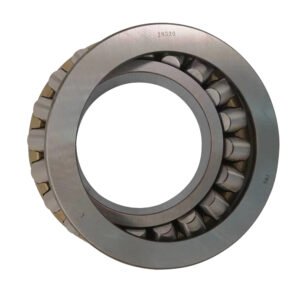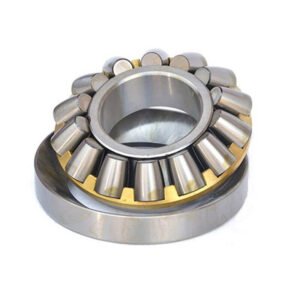Thrust Roller Bearings
Home >> Industrial Bearings >> Roller Bearings >> Thrust Roller Bearings
Have Query?
Best Thrust Roller Bearings For Machines at affordable prices
Bearings are part and parcel of industrial machinery. They help in facilitating the smoothness and long life of any rotating components. Among the various types of bearings, thrust roller bearings are fabricated especially for axial loads, where axial load is the load acting parallel to the shaft. These bearings are constructed to support high weight with the least amount of friction, and therefore they find their application in a number of different fields of heavy duty usage.
This blog of thrust roller bearings is not limited to their types and applications, but also discusses about benefits and general maintenance tips.
What Are Thrust Roller Bearings?
Thrust roller bearings are a classification of bearings specifically designed for very high axial (or thrust) loads. They not only carry principal forces parallel to the axis of rotation, but also differ from radial bearings that accommodate loads applied perpendicular to a shaft. They are usually comprised of rollers (either cylindrical, tapered, or spherical) arranged between appropriately shaped raceways that carry axial loads efficiently.
Thrust roller bearings are general and commonly those that would be used in appliances with predominating axial loads, such as gearboxes, heavy-duty vehicle transmissions, marine propulsion machinery, and even rotary tables.
Types of Thrust Roller Bearings
- Cylindrical Thrust Roller Bearings
With cylindrical rollers, these bearings accommodate heavy axial loads without any radial load. If your application involves high stiffness and low speed such as vertical shafts and industrial presses, this is the right bearing to use.
- Tapered Thrust Roller Bearings
Because of the conical shape of the rollers, tapered thrust roller bearings can take axial loads in conjunction with limited radial loads. They are prevalent in various automotive and marine applications where combined loads come into play.
- Spherical Thrust Roller Bearings
They are categorized by barrel-shaped rollers set within an equally spherical raceway allowing self-alignment of the bearing. This makes it so suitable in the case of applications with misalignment conditions, for example, in hydraulic turbines and heavy-duty pumps.
- Needle Thrust Roller Bearings
Require very thin horizontally and vertically elongated rollers for axial load; for these two reasons, they are most commonly used in compact design and limited space applications. Most of these bearings can be found in car units, especially in transmission systems.
Benefits of Thrust Roller Bearings
- High Load-Carrying Ability: The roller design provides the greater surface contact that allows the bearing to carry extremely heavy loads.
- Durability and Reliability: Made from the high-quality heat-treated materials, these bearings are built to last even in harsh environments.
- Efficiency: Smooth operations and reduced wear in machines are due to less friction.
- Versatility: There are several possible configurations to meet certain applications-from precision machinery to rough and rugged industrial equipment.
Use of Thrust Roller Bearings
Thrust roller bearings are widely used in various industrial applications.
- Automobile: Notably for transmissions and differential and suspension systems.
- Aerospace: Mostly for jet engine rotors and aircraft landing gears.
- Industrial Equipment: Machine tools, vertical shafts, and gearboxes.
- Energy: Windmills, hydro-electric generators, and oil rigs.
- Marine: Propeller shafts and steering systems.
Installation and Maintenance
To increase the service life and working capability of thrust roller bearings, they should be properly installed and well maintained.
- Alignments: The shaft and housing must be aligned properly to avoid uneven load distribution.
- Lubrication: Choose the appropriate lubricant for the operating conditions (oil or grease). Premature failure may result from over- or under-lubrication.
- Cleanliness: Dust, dirt, or moisture are all common bearing contaminants. Always store and handle bearings in clean environments.
- Check the Loads: Do not operate beyond the load and speed limits specified by the manufacturer in order not to cause undue stress on the bearing.
Conclusion
Thrust roller bearings are very much important components in systems subject to heavy axial loads. Because of their design, strength, and versatility they find applications almost all over, from the automotive to the heavy machinery and renewable energy sectors.
By choosing the appropriate type of thrust roller bearing, following correct installation, and conducting periodic maintenance, you can greatly enhance the service life of these components. If you are the design engineer for industrial equipment or the maintenance technician for the function of machinery, thrust roller bearings’ basic understanding will help make operational decisions on their behalf.
FAQs on Thrust Roller Bearing
Q1: What’s the difference between thrust ball bearings and thrust roller bearings?
A: Thrust ball bearings are using balls for rolling elements and, therefore, are suitable for lighter loads, while thrust roller bearings consist of cylindrical or tapered rollers, designed for heavier axial loads.
Q2: Will thrust roller bearings carry radial loads?
A: Most thrust roller bearings are designed principally for axial loads. However, limited radial loads may be accommodated with tapered thrust roller bearings due to roller geometry.
Q3: What is the usual life for thrust roller bearings?
A: The life of a bearing depends upon operating condition, load, speed, lubrication, and maintenance. In optimal situations, thrust roller bearings can withstand operation for several tens of thousands of hours without failure.
Q4: What are the working materials of thrust roller bearings?
A: The common materials are chromium alloy steels, stainless steels, and also in special high-performance cases, ceramics. The choice depends on the application environment and load requirements.
Q5: Are they re-lubricable or not?
A: Yes, many of the types are re-lubricable by means of grease fittings provided on the assembly or upon disassembly. Regular re-lubrication periods should be specified according to application.
If you’re looking for high-quality thrust roller bearings, check out Decent Machinery’s wide range of durable and precision-engineered bearings designed for demanding applications.


